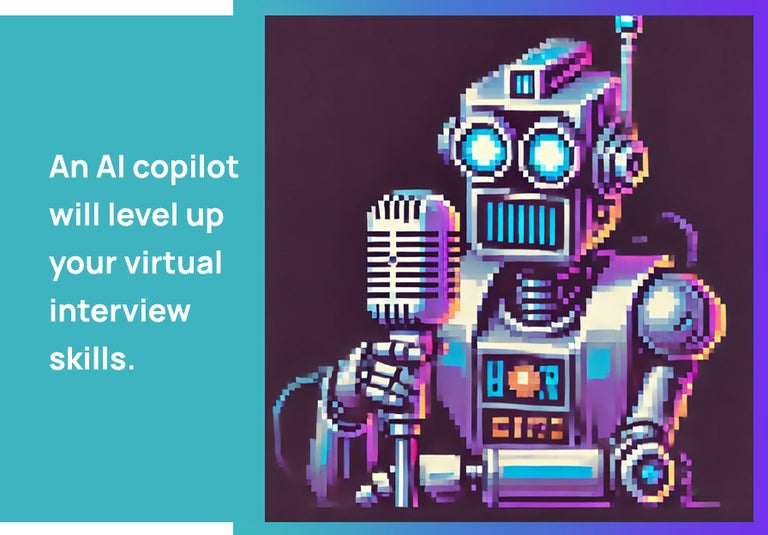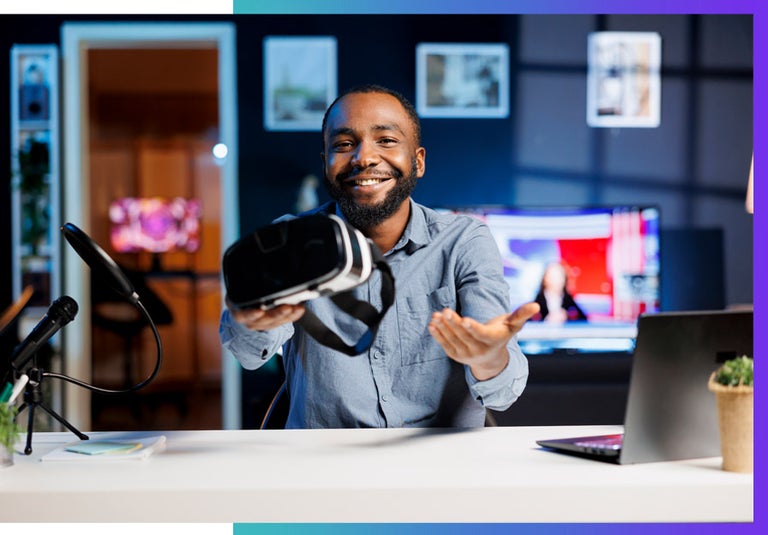Contents
- #1: Prepare for The Win
- #2: Practice Like You Mean It
- #3: Procure Your Own Feedback
- What About Crushing My Crossover Structured Interview?
- The Three P’s Power Combo: An AI Knockout
Rejection after a last round interview is brutal. Remote or not, the highest paying jobs in tech all lead to that critical virtual moment in time. Here’s how to leverage the latest AI tools and interview techniques to get that offer on the table.
You’ve done it! You braved the skill tests and passed with flying colors.
Or your resume somehow made it through AI-powered applicant tracking systems designed to eliminate people, and you’ve caught the eye of a human hiring manager.
Only 8.4% of people who apply, get interviews and this is getting lower every year.
You’re in. You’re nearly there. You’ve beaten the odds. Now all you have to do is be everything they want – and more.
Easy right!
It’s just your dream job and entire future on the line.
Oh, and you’re up against 3 other applicants who are probably a better match for the job than you are.
The stakes couldn’t be higher. Yet so few people consider virtual interviewing to be a skill.
They collect their notes, fall back on outdated Q&A responses and leave the process to chance, luck or the fates. They underprepare and blow their shot.
For me this is the definition of nuts.
It’s like standing at an arcade game for hours to get to the final stage where you’ll face the big boss – then winging it. Most people feel so lucky to get to that point that they fail to properly prepare for the big showdown.
- Indeed says 82% of employers use remote interviews to hire new candidates, whether it’s for remote, hybrid or in-person roles.
- In tech there are many interview rounds, often between 2-5, sometimes as high as 10 if there are follow-ups or post-offer interviews too.
- You are directly competing with 2-3 final round interview candidates. You better believe they’re bringing their A-game.
So, here’s what we know.
There’s a 100% chance that you will have to interview remotely for your next tech role. You’ll have to jump through hoops, which often translates to HOURS of interviews before the last round.
There’s a strong chance you’ll be frustrated or fatigued by then. And you will be competing against strong candidates in a volatile, biased and unfair system.
All things considered:
- How do you prepare when you don’t know what to expect?
- How can you practice your way to a perfect impression on-screen?
- How can you make sure you learn from every interview?
The good news is that elite remote workers are using AI power combos to crush the remote interview process. And today, I’m showing you how. Because when you get to the final stage, you need an advantage.

#1: Prepare for The Win
Do you prepare for final stage interviews?
Only 61% of people prepare answers to key interview questions ahead of time. And sure, you must cover your usual bases.
- Know the company and why you want to work there
- Know who your recruiter is and what they’re focused on
- Prepare questions to ask your hiring manager during the interview
But these basics won’t help you stand out.

Here’s what will!
- First impressions…on screen: They say you should dress for success, and they’re right (whoever they are). This applies on-screen too! Some 71% of employers won’t give you a second look if you’re not dressed well – so dress to fit into the culture. And your surroundings matter. Make an effort to stage your set like a pro. Your recruiter might pick something out of your environment to talk about!
- Your online presence: Some 92% of employers will stalk your socials. Sure, you shouldn’t have your Cabo weekend away pics on there, but its more than that. Social media is a tool for alignment. Use AI to populate your social media with topics your employer cares about. They’ll see it and will take notice.
- Streamlining your Q&As: Claude, Gemini and ChatGPT are great for helping you reformulate thoughts, simplify ideas and communicate clarity. Prepare 10 work-related stories connected to activities and results you produce in your job. Preparation is the key to good storytelling and communicating your value.
- Tech Check: Before any interview, be courteous and test your tech. It might be funny when mute won’t turn off in meetings, but technical faults don’t end well in interviews. Have contingencies for your contingencies. You’re on someone else’s valuable time.

Top Tip: Ask your AI copilot how other people answer key industry questions.
#2: Practice Like You Mean It
I was once told to look at the camera lens to make it seem like I was looking directly at my interviewer.
Terrible advice – my mind immediately went blank.
No-one is going to judge you for looking at the screen. It’s far more important that you deliver on passion, kindness and empathy in your answers.
There’s a lot of bad (and useless) advice out there about how to succeed in interviews.
It reminds me of the advice still given to experts on what to do with their hands on camera (the touching finger pyramid) – but that looks unnatural and it’s quite silly.
Instead of taking bad advice, review your own performance.
AI tools can bridge the gap for you in so many ways!

Don’t bother your SO with ‘ask me things’ then read off a ‘top 10 list’ of potential interview questions – be smarter than that.
Use AI!
Running through something once or twice is good. Practicing something until you can deliver it like a classically trained actor is another thing altogether. Drills people!
10X your impact with 10X the practice.
AI mock interviews are being used by the top 1% to prepare for ANY question. Using their carefully prepared stories and anecdotes, this is where you will practice your delivery. In real-time.
Watch or listen to your answers and adjust them to get better.
Some tools to check out:
- Create your own mock interview GPT, interviewsby.AI, Google’s Interview Warmup, Liftoff, Practiceinterview.online, Ben Ma’s free Video Interviewbot.
These AI tools will level-up your on-screen presence, charisma, tone of voice, speech delivery, clarity and speed. They’re perfect for both live and async pre-recorded interviews.
It’s so important that you look natural, relaxed and comfy on camera.
Heck, you’ll be cracking jokes with your interviewer because things will go so well after training with these tools.
Top Tip: There are AI tools that act like teleprompters – you can read off your answers as you chat with your interviewer. Believe me, they can tell. Notes are fine, but talking from memory creates the best impression!
Bonus Tip! Canned AI answers live in a final round interview won’t get you the job. If you’re using AI to try and trick your recruiter, instead of giving them genuine answers – they will know. Or you’ll just come across as a generic choice.
#3: Procure Your Own Feedback
Candidates LOVE to receive feedback on how their interview went.
But only one in ten candidates (9%) get feedback, a follow-up or any additional information after an interview.
I’m not talking about rejection notifications - those are common courtesy. I mean feedback that helps you understand your interview strengths and weaknesses.
After all, how are you supposed to get better without feedback?

Candidates get extremely upset when they don’t know what they did wrong, and that’s understandable. We’ve ALL sat through what we believed were strong interviews, only to be ghosted right afterwards. It’s awful to be left confused and demotivated like that.
For larger companies like Crossover, it’s impossible to give everyone the feedback they want. That’s the reality and one many, many other companies follow.
But – for the top 1% - that doesn’t mean they can’t collect their own…using AI.
- Use an AI tool that records, summarizes and analyses your interview.
Your AI copilot will enter the interview with you, record it for you and create a handy reviewable transcript for you to analyze when you’re done.
- I recommend tools like Otter.AI, Fireflies.AI and Final Round AI.
This is powerful for a few awesome reasons:
- You get to review your performance in video and text
- AI will run a qualitative analysis giving you data on sentiment
- Review your analytics and see what you focused on
- Impress learning-centric tech companies who love autonomous growth
A polite, ‘do you mind if my AI assistant takes notes?’ is all you have to say before adding it to the interview.
Best case scenario, you get the job. Yay! Worst case – you don’t and if this continues, you can compare your interviews to improve on your own.
If you struggle to find your weaknesses, other people can help because you have the data. Anything that can be measured, can be improved.
After that, it’s your job to improve those skills.
What About Crushing My Crossover Structured Interview?
Everyone who works on Crossover has made it past the structured interview stage – which is the final round before an offer is made.
That means we passed the CCAT, the English Proficiency tests and the real-world job skill assessments. At that point, the hiring manager knew for sure that we’d be a strong fit in the role.
All that was left, was to assess team fit.
Because culture matters more than anything else.
Interviews are a super inefficient way to filter candidates earlier in the process. They’re riddled with cognitive bias, so we spare our candidates from them until we’re sure alignment exists.
If you’ve made it this far – congrats!
VP of Talent and People Ops, Heather Lother has these tips:
- Treat the job description like it’s a cheat sheet. Our interviewers are laser-focused on one thing: do you authentically meet the requirements in the Candidate Requirements section?
- Dust off those past work experiences. Be ready to discuss work tasks you’ve tackled before - bonus points if they match up with the What You Will Be Doing section!
- Follow the STAR format (Situation, Task, Action, Result) and prepare 6-10 written stories you can use at a moment’s notice – but don’t read awkwardly from a script or it won’t go well.

Take Note: The hiring and support teams can’t directly answer your questions about what to expect in interviews.
Use the tips above instead.
At Crossover, once you’ve had an interview, there are no more assessments. These always come before the structured interview stage!
It’s designed to save you time so that you won’t have to sit through 6 hours of interviews, doing erroneous assignments for different people.
If that ever happens, please report it here.
You can learn more about our selection process here.
The Three P’s Power Combo: An AI Knockout
If you’ve ever made it through a grueling hiring process only to be knocked out in the final stages, the 3P’s combo will get you back on track.
It’s an incremental system designed to leverage AI to maximize opportunity and minimize bombing in a final round interview.
Use this power combo to crush that remote interview and land your dream job.
Success is about more than preparation these days. You need to have the presence of mind to prepare, the drive to practice and the willingness to learn from your own mistakes – without relying on old structures or mindsets.
Hiring managers are busy.
They don’t owe you their time. But you owe yourself a shot at gaining the most valuable skill in tech today: remote interviewing.
Don’t leave your future to chance, to luck or to the fates - use AI to maximize your impact. Make AI your co-pilot and when you do reach that coveted final stage – you’ll win.
Now get out there and make your life happen.









